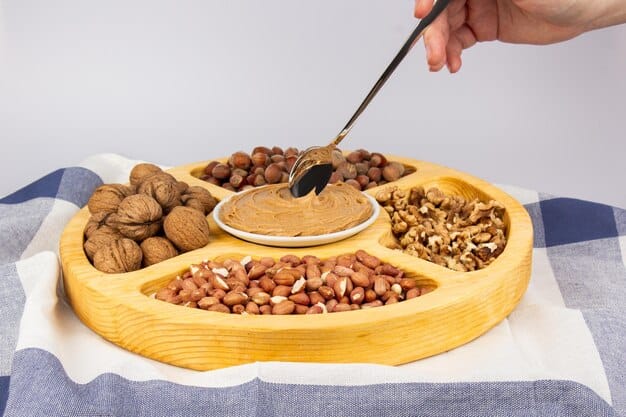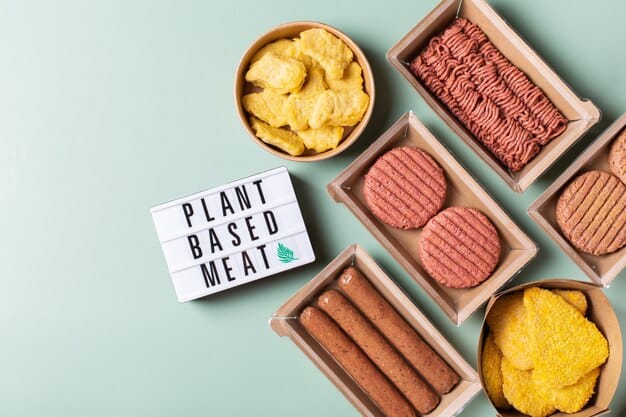Unexpected Foods Sabotaging Your Weight Loss: A Deep Dive

Achieving sustainable weight loss often requires a keen awareness of hidden dietary pitfalls, and understanding how seemingly benign foods may inadvertently hinder your progress is crucial for long-term success.
Embarking on a weight loss journey is a commitment to a healthier self, yet it’s common to encounter plateaus or unexpected hurdles despite diligent effort. While the usual suspects like fast food and sugary drinks are well-known, could there be 3 unexpected foods that are sabotaging your weight loss goals lurking in your pantry or daily routine? This article delves into often-overlooked culprits that might be secretly undermining your efforts, offering insights grounded in nutritional science and practical advice to help you navigate your path to success.
The Deceptive Allure of “Healthy” Snacks
Starting a weight loss journey often involves swapping out obviously unhealthy items for what seem like better alternatives. However, many snacks promoted as “healthy” can be surprisingly caloric and nutrient-deficient, capable of derailing even the most well-intentioned diet. These foods often leverage clever marketing, giving off an aura of health while secretly packing a punch of sugar, unhealthy fats, or excessive calories. The packaging might highlight a single “good” ingredient, like whole grains or a low fat claim, while conveniently downplaying the high sugar content or large serving sizes. This selective messaging can create a false sense of security, leading people to consume these items in quantities that far exceed their dietary needs.
Consider the common perception of granola bars as a healthy on-the-go option. While some varieties are indeed packed with beneficial nuts, seeds, and oats, many are effectively glorified candy bars. They can be loaded with added sugars, syrups, and unhealthy oils, pushing their calorie count sky-high. A single bar might contain as much sugar as a chocolate chip cookie, nullifying the perceived benefits of its fiber content. Similarly, fruit juices, often seen as a healthy way to consume vitamins, can be incredibly deceptive. Without the fiber present in whole fruits, the concentrated sugars in juice are absorbed quickly, leading to blood sugar spikes and subsequent crashes, which can trigger cravings and overeating. The lack of fiber also means they provide little satiety, making it easy to consume large quantities without feeling full.
The Silent Saboteurs: Granola, Dried Fruits, and Fruit Juices
Many processed “healthy” snacks are designed to be palatable, often achieving this through a combination of sweet and savory elements that can be incredibly addictive. The texture, flavor, and convenience contribute to overconsumption. Take for instance, seemingly harmless rice cakes or vegetable chips. While low in fat, many are high in refined carbohydrates that offer little nutritional value and can lead to rapid blood sugar fluctuations.
- Granola: Often a mix of oats, nuts, and dried fruits, but frequently bound together with high-calorie sweeteners and oils. A small serving can easily exceed 400 calories, making it a meal rather than a snack.
- Dried Fruits: While they retain many nutrients from fresh fruit, the drying process concentrates their sugar and calorie content. A handful of dried cranberries or apricots can contain as much sugar as a full-size chocolate bar.
- Fruit Juices: Lacking fiber, juices deliver a concentrated dose of sugar and calories without the satiety of whole fruit. Many commercial juices also contain added sugars, further exacerbating the issue.
The key lesson here is to always scrutinize nutrition labels, even for items positioned as wholesome. Pay close attention to serving sizes, added sugars, and fat content. Understanding what truly constitutes a healthy snack empowers you to make informed decisions that support, rather than undermine, your weight loss aspirations. It’s not about demonizing these foods entirely, but about being aware of their caloric density and making conscious choices about their consumption. A deep dive into the nutritional facts will reveal whether these items are truly allies or foes in your dietary journey.
The Hidden Sugars in Seemingly Savory Foods
When contemplating dietary changes for weight loss, sugar is undeniably a primary target. Most people are well aware of its presence in obvious culprits like sodas, candies, and desserts. However, the pervasive nature of sugar in our food supply means it often hides in plain sight, disguised within foods we perceive as savory or even “healthy.” This stealthy sugar infiltration is a significant challenge, as it can contribute to a substantial amount of hidden calories and metabolic disruption without us even realizing it. The food industry often adds sugar not just for sweetness, but also as a preservative, a bulking agent, or to enhance texture and palatability, making it ubiquitous across a wide range of products.
Many processed foods, even those not intended to be sweet, cunningly incorporate various forms of sugar. Consider, for example, typical breakfast cereals. Even “whole grain” or “bran” varieties can contain significant amounts of added sugar, turning what seems like a sensible start to the day into a sugar bomb. Similarly, common condiments like ketchup, BBQ sauce, and salad dressings are often laden with high-fructose corn syrup or other caloric sweeteners. These additions transform what should be flavor enhancers into significant sources of empty calories, adding up quickly throughout the day. The insidious part is that these sugars are often not explicitly labeled as such but appear under various aliases, making them harder to identify.
Navigating the Labyrinth of Sugar Aliases
The food industry employs over 50 different names for sugar, making it incredibly challenging for the average consumer to identify its presence on ingredient lists. This deliberate obfuscation allows manufacturers to present products as having lower “sugar content” while still relying heavily on various caloric sweeteners. Common aliases include corn syrup, dextrose, fructose, glucose, high-fructose corn syrup, lactose, malt syrup, maltose, molasses, sucrose, and various “syrups” like maple, agave, or rice syrup. Even terms like “evaporated cane juice” or “fruit juice concentrate” are essentially just sugar.
- Sauces and Condiments: Ketchup, BBQ sauce, salad dressings (even “light” ones), and marinades are frequently packed with added sugars. A single serving of ketchup can contain a teaspoon of sugar.
- Yogurt: Many flavored yogurts, even those marketed as healthy or low-fat, contain more sugar than a serving of ice cream. Opt for plain, unsweetened yogurt and add your own fresh fruit.
- Bread and Baked Goods: Surprisingly, even savory breads and rolls can have added sugars to aid in fermentation and browning. Always check the ingredient list for hidden sweeteners.
The key to avoiding these hidden sugars lies in diligent label reading. Look beyond the “Nutrition Facts” panel to the ingredient list. If any form of sugar is listed among the first few ingredients, or if multiple forms of sugar appear throughout the list, the product is likely high in added sugar. Choosing whole, unprocessed foods as much as possible is the most effective strategy to minimize hidden sugar intake, ensuring your diet truly supports your weight loss goals rather than secretly undermining them with unsuspected sweet additions.
The Overlooked Calorie Density of “Healthy” Fats
Fats have long been a hot topic in nutrition, often demonized in the past. However, modern science has clarified that not all fats are created equal, and many are essential for health. The challenge for weight loss lies not in avoiding fats entirely, but in recognizing their significant calorie density, even the “healthy” ones. While monounsaturated and polyunsaturated fats, found in avocados, nuts, seeds, and olive oil, offer numerous health benefits—including improving heart health and aiding nutrient absorption—their caloric load is far higher per gram than carbohydrates or proteins. A little bit of these healthy fats goes a long long way in terms of calories.
This caloric density often leads to unintentional overconsumption. For example, a generous pour of olive oil over a salad or a hearty handful of nuts as a snack can quickly add hundreds of calories without providing a proportionate feeling of fullness. Many people mistakenly believe that because a food is “healthy” and rich in good fats, they can consume it in unlimited quantities. This is particularly true for items like nut butters, which are incredibly dense in calories and can sneakily add up if consumed in excess beyond the recommended serving size. The perceived health halo around these fats can unfortunately lead to a disregard for portion control, turning a beneficial food into a hindrance for weight loss.

When “Good” Fats Go Rogue: Nuts, Avocados, and Oils
The concept of moderation is paramount when incorporating even the healthiest fats into a weight loss plan. While beneficial, their energy concentration necessitates careful portion management. Without it, the daily caloric intake can quickly surpass expenditure, halting progress. This is not to say these foods should be avoided; rather, they should be integrated thoughtfully, with a keen eye on quantities. Embracing balance means understanding that even nutrient-rich foods require mindful consumption to align with caloric goals.
- Nuts and Nut Butters: While excellent sources of protein, fiber, and healthy fats, a small handful of almonds or a tablespoon of peanut butter packs around 100-200 calories. Portion control is absolutely critical for these items.
- Avocados: A fantastic source of healthy monounsaturated fats and potassium, but a whole avocado can contain over 300 calories. Using half an avocado or a quarter as a serving is often more appropriate for weight loss.
- Cooking Oils: Olive oil, coconut oil, and other healthy oils are calorie-dense. A tablespoon can contain 120 calories. Be mindful of how much oil you use in cooking and dressing salads. Using non-stick pans or spray oils can help control this.
To effectively manage calorie intake from healthy fats, incorporate them mindfully. Measure out portions of nuts, use oil sprays instead of pouring, and be aware of the amount of avocado or nut butter in your meals. These fats are invaluable for satiety and overall health, but like all energy sources, they must be consumed in amounts that align with your weight loss objectives. Think of them as concentrated fuel; necessary, but potent.
Processed Gluten-Free Products: A Misunderstood Ally
The rise of gluten-free diets has been significant, driven by increased awareness of celiac disease and non-celiac gluten sensitivity, or simply by the perception that “gluten-free” equates to healthier. However, a common misconception is that all gluten-free products are inherently healthier or lower in calories, especially for those without a medical need to avoid gluten. This isn’t always the case, and for many, relying too heavily on processed gluten-free alternatives can inadvertently hinder weight loss efforts. The reality is far more nuanced, and simply swapping a regular cookie for a gluten-free one might not yield the expected health benefits.
Many processed gluten-free foods, such as breads, pastas, cakes, and cookies, are manufactured to mimic the taste and texture of their gluten-containing counterparts. To achieve this, manufacturers often replace wheat flour with refined starches like rice flour, corn starch, potato starch, or tapioca starch. These refined flours often have a higher glycemic index than wheat flour, meaning they can cause quicker spikes in blood sugar, potentially leading to increased hunger and fat storage. Furthermore, to compensate for the lack of gluten, which provides elasticity and structure, these products often contain more added sugars, unhealthy fats, and emulsifiers to improve palatability and shelf life. This makes them surprisingly calorie-dense and nutritionally inferior.

The Refined Starch Trap and Added Sugars
The primary issue with many processed gluten-free foods is their nutritional profile. They often lack the fiber and micronutrients found in their whole-grain, gluten-containing equivalents. Without sufficient fiber, these foods offer little satiety, making it easier to overeat. The increased sugar content is a further concern, as it directly contributes to calorie intake and can drive cravings, countering weight loss goals. This creates a cycle where individuals feel less full, consume more calories, and experience more pronounces sugar crashes, which often leads to more snacking.
- Gluten-Free Breads and Pasta: Often made from refined starches, which can elevate blood sugar rapidly and lack the fiber of whole-wheat versions.
- Gluten-Free Baked Goods: Frequently contain more added sugars and unhealthy fats to compensate for texture, making them calorie bombs despite being gluten-free.
- Gluten-Free Snacks: Many gluten-free pretzels, crackers, and chips are highly processed and offer minimal nutritional value, packed with empty calories.
For individuals who *must* avoid gluten due to celiac disease or sensitivity, the focus should be on naturally gluten-free whole foods such as fruits, vegetables, lean proteins, legumes, quinoa, brown rice, and oats (certified gluten-free). For those choosing gluten-free for perceived health benefits, a critical reassessment is needed. Prioritize whole, unprocessed foods and read labels carefully for sugar and fat content, regardless of whether a product is labeled “gluten-free.” True healthy eating for weight loss involves nutrient density and calorie awareness, not simply the absence of gluten.
Mindful Eating and Portion Control as Countermeasures
Understanding which foods might be subtly undermining your weight loss efforts is only half the battle; the other half involves implementing effective strategies to counteract these challenges. Two powerful tools in your arsenal are mindful eating and rigorous portion control. These practices shift the focus from strict dietary restrictions to a more sustainable, aware approach to food consumption, which is crucial for long-term success rather than quick fixes. Mindful eating is about paying attention to your food, your body’s signals, and the eating experience, rather than passively consuming. It involves being present in the moment and truly savoring your meals, free from distractions.
Portion control, on the other hand, is the practical application of knowing how much you should be eating. Even healthy foods can lead to weight gain if consumed in excess, as all food contains calories. Together, mindful eating and portion control form a robust framework for managing caloric intake without relying on deprivation or complicated dietary rules. They empower you to make conscious choices, fostering a healthier relationship with food and your body. The synergy between these two practices creates a powerful force for managing overall food intake.
Strategies for Success: Practicing Awareness and Measurement
Integrating mindful eating into your daily routine involves conscious effort but yields significant benefits. Begin by eating slowly, chewing thoroughly, and putting your fork down between bites. Pay attention to the flavors, textures, and aromas of your food. Tune into your body’s hunger and fullness cues – eat when you’re truly hungry and stop when you’re comfortably full, not stuffed. Avoid distractions like screens while eating, as these can lead to mindless overconsumption. This practice also helps in distinguishing between physical hunger and emotional hunger, an important step in preventing unnecessary caloric intake.
For portion control, practical tools and techniques are invaluable. Utilizing measuring cups and food scales, at least initially, can help you learn appropriate serving sizes for various foods, especially those that are calorie-dense but seemingly healthy. Visual cues can also be helpful; for instance, a serving of nuts might be equivalent to a small handful, or a deck of cards for protein. Planning meals ahead of time and pre-portioning snacks can prevent impulsive overeating.
- Read Nutrition Labels: Always check the serving size and total calories, even for healthy items. Don’t assume.
- Measure Your Food: Use measuring cups, spoons, or a food scale to accurately portion calorie-dense foods like nuts, oils, and grains.
- Plate Method: Fill half your plate with non-starchy vegetables, a quarter with lean protein, and a quarter with whole grains or starchy vegetables.
- Listen to Your Body: Pay attention to hunger and fullness cues. Eat when you’re hungry, stop when you’re satisfied, not stuffed.
By combining mindful eating with portion control, you develop a more intuitive and sustainable approach to managing your diet. This isn’t about rigid restrictions but about building awareness and making informed choices that align with your weight loss goals, ultimately leading to a healthier, more balanced lifestyle where food serves as nourishment, not an adversary. These practices empower you to take charge of your eating habits for lasting success.
Beyond the Label: Prioritizing Whole, Unprocessed Foods
In the intricate landscape of modern nutrition, a fundamental principle for weight loss and overall health often gets overshadowed by diet trends and marketing hype: the unparalleled importance of prioritizing whole, unprocessed foods. This approach stands in stark contrast to relying on packaged “health” items, many of which are designed to appear beneficial but carry hidden caloric and nutritional pitfalls. Focusing on foods in their most natural state simplifies the dietary process, eliminates hidden ingredients, and naturally promotes satiety and nutrient density without the need for constant label scrutiny for every “unexpected saboteur.”
Whole foods are, by definition, foods that have been minimally processed or refined, and are free from added sugars, unhealthy fats, and artificial ingredients. This category includes fresh fruits and vegetables, lean proteins (like chicken, fish, and legumes), whole grains (such as quinoa, brown rice, and oats), and healthy fats directly from their natural sources (like avocados and unroasted, unsalted nuts in moderation). These foods inherently offer a higher concentration of vitamins, minerals, and dietary fiber, which are crucial for metabolism, digestion, and prolonged feelings of fullness, effectively reducing the likelihood of overeating on empty calories.
Building a Foundation for Sustainable Weight Loss
The benefits of a diet rich in whole foods extend far beyond mere calorie control. The high fiber content in fruits, vegetables, and whole grains aids digestion, stabilizes blood sugar levels, and contributes significantly to satiety. This means you feel fuller for longer, reducing the temptation for unplanned snacking or overeating at subsequent meals. Moreover, whole foods provide a complex array of micronutrients that support all bodily functions, including energy metabolism, which is vital for efficient weight management. The natural absence of artificial additives and excessive sodium also supports overall well-being.
- Fruits and Vegetables: High in fiber, vitamins, and water content, they are naturally low in calories and promote satiety. Consume a wide variety of colors.
- Lean Proteins: Essential for building and repairing tissues, and highly satiating. Opt for chicken breast, fish, tofu, beans, and lentils.
- Whole Grains: Provide sustained energy and fiber. Prioritize quinoa, oats, brown rice, and whole-wheat bread over refined grains.
- Healthy Fats from Natural Sources: Avocados, nuts (in moderation), seeds, and olive oil provide essential fatty acids. Used sparingly, they boost satiety and nutrient absorption.
By basing your diet around these fundamental whole foods, you naturally reduce your exposure to the “unexpected foods” that can sabotage weight loss. You gain control over your caloric and nutrient intake, fostering a sustainable eating pattern that truly supports your health goals. This approach isn’t about complicated rules or restrictive diets; it’s about returning to the basics of eating simple, nourishing foods that your body is designed to thrive on, paving the way for consistent and healthy weight loss.
Navigating Social Settings and Eating Out
Weight loss journeys typically face significant challenges when navigating social settings and dining out, especially when the focus shifts from meticulously prepared home meals to restaurant menus or casual gatherings. The foods served in these environments, while often delicious and convenient, can easily become the “unexpected foods” that sabotage weight loss goals. Restaurants often prioritize flavor and presentation over nutritional content, meaning dishes can be laden with hidden fats, sugars, and excessive calories, far exceeding typical serving sizes or daily requirements. This makes it difficult to maintain dietary discipline and caloric awareness without careful planning.
The pressure to conform in social situations can also lead to overeating or making poor food choices. Whether it’s sharing appetizers, indulging in dessert because everyone else is, or simply misjudging portion sizes in an unfamiliar setting, these moments can derail progress. Additionally, many restaurant dishes use high amounts of cooking oils, butter, and rich sauces, which significantly boost calorie counts without being immediately obvious. Even seemingly healthy options, like a large salad, might come drenched in a heavy dressing or topped with high-calorie additions, transforming it from a light meal into a caloric bomb.
Strategies for Conscious Choices Outside the Home
Success in social and dining-out scenarios hinges on proactive planning and assertive decision-making. Before heading to a restaurant, it’s often helpful to review the menu online, if available. This allows you to identify healthier options in advance and plan your meal without feeling rushed or pressured. Many establishments now provide nutritional information, making it easier to make informed choices that align with your dietary goals. Don’t hesitate to ask for modifications, such as dressings on the side, lean protein sources, or extra vegetables.
At social gatherings, consider eating a light, healthy snack beforehand to curb extreme hunger, which can lead to overindulgence. Focus on socializing rather than just on the food, and be mindful of alcohol consumption, as alcoholic beverages contribute significant “empty” calories. When faced with a buffet, prioritize vegetables and lean proteins first, and then sparingly add smaller portions of other desired items.
- Pre-Plan: Look up restaurant menus online to choose healthier options in advance.
- Ask for Modifications: Request dressings on the side, steamed vegetables instead of fried, or grilled protein instead of fried.
- Portion Awareness: Ask for half-portions or take half your meal home as leftovers to avoid overeating.
- Mindful Drinking: Be aware of the caloric content of alcoholic beverages and choose lighter options or alternate with water.
- Focus on Fellowship: Shift your attention from endless eating to enjoying the company and conversation.
Navigating social eating successfully doesn’t mean becoming socially isolated or depriving yourself; rather, it’s about making conscious choices and finding balance. With a strategic approach, you can enjoy social occasions without compromising your weight loss journey, reinforcing the idea that sustainable health is about integrating healthy habits into all aspects of life, not just within the confines of your own kitchen.
| Key Point | Brief Description |
|---|---|
| 🍎 “Healthy” Snacks | Granola, dried fruits, and juices often harbor excessive sugars and calories, despite their healthy image. |
| 🍯 Hidden Sugars | Savory foods and condiments like ketchup, sauces, and flavored yogurts can be surprisingly high in added sugars. |
| 🥑 Calorie-Dense Fats | Healthy fats from nuts, avocados, and oils are beneficial but can quickly add up in calories if portions aren’t controlled. |
| 🥖 Processed GF Foods | Many processed gluten-free items are made with refined starches and added sugars/fats, hindering weight loss despite being GF. |
Frequently Asked Questions
No, not all “healthy” snacks are bad, but many processed ones like some granola bars, dried fruits, and fruit juices can be high in hidden sugars and calories. It’s crucial to read nutrition labels carefully and prioritize whole, unprocessed options for truly beneficial snacking.
Hidden sugars often appear under various names on ingredient lists, such as corn syrup, dextrose, fructose, maltose, or even agave nectar. Check the ingredient list thoroughly, especially if sugar or its aliases are listed among the first few ingredients, in products like sauces or condiments.
No, healthy fats are essential for overall health and satiety. However, they are calorie-dense. The key is portion control. Measure out servings of nuts, seeds, avocados, and cooking oils to ensure you’re consuming them in amounts that align with your daily caloric goals.
Not necessarily. While essential for those with gluten sensitivities, many processed gluten-free foods replace gluten with refined starches and often add more sugars and unhealthy fats to improve taste and texture. For weight loss, prioritize naturally gluten-free whole foods over processed alternatives.
The most effective strategy involves a combination of mindful eating, strict portion control, and prioritizing whole, unprocessed foods. Always read nutrition labels diligently, and be aware of how ingredients contribute to the overall caloric and nutritional profile of what you consume.
Conclusion
Navigating the complex world of nutrition during a weight loss journey can feel like a constant battle against hidden adversaries. While the common culprits are usually easy to spot, many seemingly innocuous or even “healthy” foods can subtly undermine your efforts. By understanding and addressing the deceptive nature of these unexpected foods that are sabotaging your weight loss goals—from sugar-laden “healthy” snacks to calorie-dense healthy fats and tricky processed gluten-free products—you empower yourself with knowledge. This awareness, coupled with mindful eating, diligent portion control, and a strong emphasis on whole, unprocessed foods, forms the cornerstone of sustainable and successful weight management. Remember, true progress comes not from deprivation, but from informed choices and a deeper understanding of what truly nourishes your body without hidden costs to your caloric goals.





